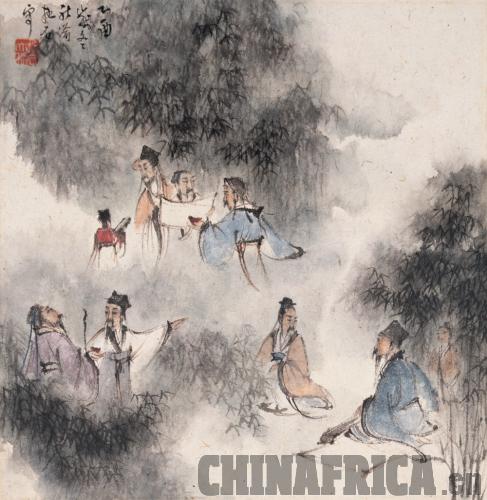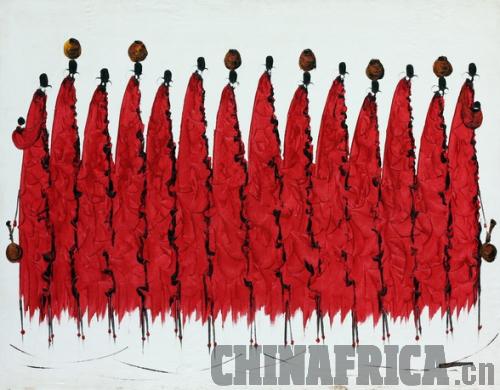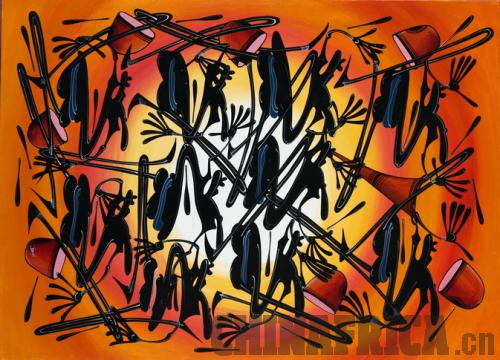| The Tinga Tinga painting style was pioneered by Edward Said Tingatinga in Tanzania in 1968. But it was only after his death that his art started to attract attention from the masses. People visiting Tanzania were moved by pieces painted in this style, and Tinga Tinga paintings gradually reached a broader audience, eventually gaining international recognition. Featuring unaffected lines and rich colors, this art frequently explores universal themes such as nature worship, love and working together.
This September, an exhibition of Tinga Tinga paintings sponsored by Africa Focus was displayed in Tianjin. After seeing the exhibition, two artists from China and Africa share their thoughts on art with ChinAfrica.
 |
|
Seven Sages of the Bamboo Grove |

Lu Yongxiu,
Deputy Director of Tianjin Art Museum
This is the first time that the Tianjin Art Museum, founded in May, 2012, has held an international art exhibition. Chinese people have little knowledge about African art, so when we advertised the Tinga Tinga painting exhibition in the local newspaper, many readers called us for more information about the style. Some even asked about specifics such as the types of paint and materials used to create the pieces. Two African artists invited by the museum were also on hand to speak to Chinese painters and art enthusiasts, providing further insight into African culture and painting.
Observers find that these African paintings are markedly different from Chinese paintings. For a few weeks prior to the opening of the Tinga Tinga exhibition, we held an exhibition of Chinese ink paintings by a number of young artists. Their style and use of ink to depict moods and artistic concepts is familiar to Chinese people. But viewing the Tinga Tinga paintings currently on display is a completely fresh experience for our visitors. Bold colors are employed to produce sharp contrasts. In terms of their style and themes, most of the paintings focus on depicting animals and daily life. The artists directly record what their eyes see. The paintings depict the truth of what the artists see with sincerity.
Chinese art, painting and calligraphy all attach importance to expressing mood and artistic vision through painting with ink. For example, in a work titled Fishing, the painter only depicted the smooth surface of the water and a fish hook. You cannot see any fish or fisherman, but viewers still understand that it's about fishing from clues shown in the simple scene. As this painting demonstrates, mood and atmosphere play a huge role in Chinese paintings. In the famous work Seven Sages of the Bamboo Grove, the scene is composed of several simply-depicted figures, but the painter's feelings and emotions are still clear to viewers.
This style of artistic expression is grounded in Confucian culture. Over thousands of years, Chinese culture has influenced generations of artists. And, as art styles changed, they came to embrace and reflect Confucian ideas. Because of this, foreigners who know little about Chinese culture may find it hard to understand Chinese art. But for those with a deep understanding of Chinese culture, the meaning and significance of such artworks is more readily apparent.
If we roughly classify artistic styles as either impressionist or realistic, Chinese art often falls into the impressionist category. But meticulous painting (a style of Chinese ink painting) is in somewhere between impressionistic and realistic. That is not to say that Western paintings are all entirely realistic; the West is also home to painting traditions such as abstract, post-modernism and romanticism. But these are bolder and use richer colors than seen in Chinese painting. However, in recent decades, Chinese painting styles have also experienced changes. Some works by young artists embrace innovation, expressing Chinese culture with pink tones and other unusual colors.



Emanuel Moses Onasaa
a Tanzanian artist
Edward Said Tingatinga, founder of the Tinga Tinga style of painting, died 30 years ago. But because its unique characteristics distinguish it from all other African art, many people still study his art. His style reflects Tanzanian culture, depicting scenes from people's lives, and many aspects of Tanzanian society.
African art often makes use of rich, vibrant colors, and this is particularly true of paintings done in the Tinga Tinga style. While many artists are very cautious in how they use color in their work, and usually limit themselves to using only one or two colors, Tingatinga was unafraid of using different colors in his work. Because he used such a wide variety of colors in his paintings, he inspired many artists in Tanzania, allowing them to learn more about the techniques and ideas behind Tinga Tinga.
African art has a long, rich history. Modern African artists continue this tradition, often using one painting to tell many stories. In recent years, Africa has suffered through many hardships including war, hunger and societal problems. Some countries are now trying to develop and forget their past struggles. But artists use their creations to depict past misfortunes because they reflect the personal life experiences of many artists. Everything that African artists experience is shown through art, and this is what makes African art different from other artistic traditions. Art from other cultures may reflect different things, but Africans show the reality of daily life in Africa in their art.
African art is free from outside influence, and its distinctive style and content are both an important part of its beauty. African artists strive to keep their art unique, honoring its origins and staying true to its traditions. They have never been influenced by any other tradition or culture, as is the case with Western art. Africa has a very rich culture, and does not need outside influence to create art.
But within the broad category of African art, every artist has his own style. My own paintings bear some resemblance to Tinga Tinga works, but do not quite fit into that style of painting. I use lines like those seen in Tinga Tinga paintings, but I use fewer colors, and have explored more abstract styles. I also enjoy painting landscapes, and have been inspired by a Chinese artist and his painting techniques. He fills a container with water, and paints with colors suspended on the surface. But I have also met Chinese artists who use more traditional brush-and-ink methods to produce art, and others who do sand art. |